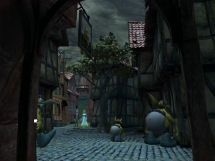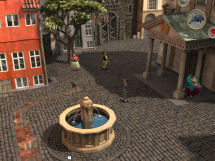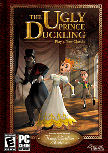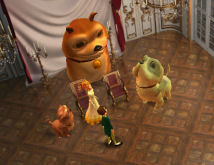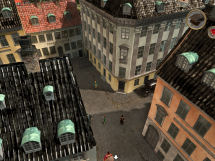“I will leave this prince-forsaken palace to explore
the world,” pouts the Princess on her fifteenth
birthday. And she proceeds to do just that. Along her way to romance, she
also manages to throw a magical gift into the dirt. This act of distain
sets off a chain of events that will leave the townspeople running for
their lives from goblins, and she the prey of the Master of Darkness.
It is clear we need a hero, and along comes the
ungainly, unattractive Hans Andersen without a penny to his name. Hans
yearns for a career in theater and he harbors a naiveté about Princesses
and the likelihood of a romance with one. He will quickly have to find
employment, improve his social status by dressing well, and of course,
keep the spoiled Princess and the rest of the town from a drastic end.
In this game from the developer Guppyworks, the story
does not follow the classic fairy tale of The Ugly Duckling, but rather
shows bits and pieces of the life of the famed Danish author and poet Hans
Christian Andersen. Andersen is the Ugly Prince Duckling. It is Andersen
who does not look like a Prince, with his unattractive features and ragged
clothing. But underneath the illusory trappings, it is Andersen who has
the courage and imagination to save the Princess and the world.
I think the developers do this rather well -- depicting
this strange parallel between Andersen the writer and the younger fairy
tale Andersen who is the game’s protagonist. It is said that, as a small
boy, Andersen made a puppet theater and played for long hours with his
characters. Being very poor, he was forced to seek employment at an early
age. He worked for a tailor prior to his short stint in the theater. He
soon found that was not his forte, but writing was his strength. He caught
the attention of the King, who sent him to school. He had unrequited
loves. From poverty he rose to great acclaim as an author of fairy tales.
Playing the Game:
“Fetch me a dead crow, some snail slime and some
snake juice.” (HCA: The Ugly Prince Duckling)
Playing from a third person perspective, we begin as
Andersen enters the town from the hills of nowhere. It is here that I
think the developers make their first mistake. Before you are engaged in
the story line, your character is repeatedly thrown out of town by the
police because he has no money or employment. Although it is clear that
you must obtain those two things to progress, it is disconcerting to begin
a game in this manner. No matter how cleverly you move your character or
how quickly, the game forces this action to occur. After this false start
(or several), the police will pay less attention, and unless you run right
into them you can begin your investigation of the town.
It is unfortunate that game play begins in this manner,
as the town is full of delights to discover. The winding cobblestone
streets and pastel buildings of the 1800s hold many interesting
characters, some of whom you will recognize from fairy tales. A mermaid, a
shepherdess, a swineherd, a little girl selling matches -- all go about
their business with the other characters, and all are available for
interaction with you. Engaging each will provide a one-way conversation,
as Andersen never speaks. Some of what is said will give clues for
progress in the game. At other times these characters will set you off on
a quest of a seek-and-fetch variety or assign to you a simple task, such
as walking the pig.
There are also several other characters who will
indicate their displeasure with Andersen, either calling for the police to
escort him out of town, making fun of his appearance, or even trying to
thwart him. Sometimes you must engage a character more than once to
receive new information, and often the response is different when you
encounter the same character in a different neighborhood. The police are
slow-moving and cover a small area, but if you stand near one you will
most likely be thrown out of the neighborhood unless you have a ready
bribe.
There are five neighborhoods in the town, and Andersen
must earn money and get better clothes to fit into the progressively
higher social circles represented by each neighborhood. Besides doing
tasks for money, he must seek employment. In addition, kicking various
barrels and other items will often surprise with a hidden coin.
(While I am on the subject of kicking things, here is a
note to the developers: Why on earth did you make it necessary to kick
roosters?)
In the midst of all this is, of course, the story line
of the Princess and the town in danger. At various points the sky will go
dark, and rather bumbling goblins lurch about the town. You must navigate
Andersen and sometimes the Princess out of danger. This is a simple matter
and is not timed, and your character cannot die. The worst that can happen
to you is that you find yourself starting the sequence from another
direction, and you will lose coins if the goblins touch you. You can
easily double click to run past the slow goblins.
There are no sliders, no color or music puzzles and one
maze. Besides the aforementioned inventory and navigation puzzles, there
are also some logic and machinery type puzzles that are very basic in
nature.
I thought the ending far from satisfactory. It may have
been true to Andersen’s sometimes offhanded story endings, but I saw it as
an opportunity missed in regard to the big-eyed orphan girl.
Mechanics:
“No wonder you’re so thin – nothing can grow in the
shade of that nose.” (HCA: The Ugly Prince Duckling)
What is a rather enchanting story falls short when it
comes to the game controls. You can utilize either mouse or keyboard, but
neither is particularly satisfactory. You can point and click and follow
directional arrows around the streets. Sometimes the action will not
engage. Sometimes the arrows won’t show up. You can also click your left
mouse button and keep it pressed as you maneuver your character. This
works better, although you will still find yourself at the edge of
screens, forced to make a move at the edge several times until the
character can go on.
Changing screen views make some puzzles much more
difficult than they need be, with the icon for a necessary action not
appearing. Even when there is no view change, on occasion no action icon
appears – for instance, in the underground when confronted with the dogs.
Then, instead of an action icon appearing, it was necessary to press the
space key on the keyboard for the appropriate response. Entering into
buildings, climbing down ladders – sometimes I would get the action icon
and sometimes I would not. This is particularly frustrating when you do
not know which buildings you can enter, and therefore have to guess which
you should keep trying to find a way into.
When there is the occasion for its use, the Inventory
flashes onto the screen via a wheel in the upper right-hand corner of the
screen. Or you can elect to have the Inventory displayed all the time
through the menu options. The item displayed most prominently is the
object that will be used. A problem with this default setting occurs in
several circumstances. If your coin purse is in the active position, it
will automatically give out coins when you are in a situation where this
action is possible (such as encountering those begging for coins, or at a
street stall full of wares). You may only be trying to elicit dialog, but
by clicking on the character, you find yourself losing your precious
coins.
Once the inventory wheel appears, you scroll through the
items by way of the scroll wheel on your mouse. This is important, for if
the particular item you need is not in the active position, the action
that you need to take place on the screen will not occur, and the
inventory wheel may flash off the screen before you realize the mistake.
Much better to select “always display inventory” from the options menu.
You can save at any point, and your saves will be
displayed by a time and a picture. I didn’t encounter any shortage of
available save slots.
The game froze at one point in the laboratory.
Visuals and Sound:
“The pennant of Knight Swanfeather: What a graceful
swan! I bet there is a story behind this image.” (HCA: Ugly Prince
Duckling)
The graphics and the story are the strength of this
game. Visually it is lovely, with a cartoon style rendition of Copenhagen
during the 1800s. The uneven cobblestones paving the streets beckon the
player to discover what is just around the corner. Pastel houses with
artistically opened windows, uneven roofing and other enhancements make
the town come alive. Even here there is a nod to Andersen and his view of
the illusory nature of society. Behind many buildings that majestically
show a faultless finish to the street side are other walls that show paint
peeling and grime. There is standing water in the streets.
The ladies wear the brightly colored fashions of the
time, with different elaborate hairdos. The males are likewise
appropriately attired. They all look somewhat like marionettes, which I am
assuming they were meant to, given the beginning animation.
The music is orchestral, operetta-like in nature and
fits the game well. Characters are well voiced. There is ambient sound,
primarily as clues for progression.
Odds and Ends:
“Most of what I have written is a reflection of
myself.” (Hans Christian Andersen)
The game is on two CDs, which do not have to be in the
computer drive to play.
It is not alt/tab friendly.
This is the developers’ first game. There are flaws, but
there is much of which they should be proud. With some adjustments to the
mechanics, their next game will be one to look forward to.
Grade: B -
March 2007
design copyright ©
2007
GameBoomers
Group
